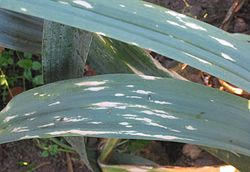Phytophthora (from Greek φυτόν (phytón), “plant” and φθορά (phthorá), “destruction”; “the plant-destroyer”) is a genus of plant-damaging Oomycetes (water molds), whose member species are capable of causing enormous economic losses on crops worldwide, as well as environmental damage in natural ecosystems. The genus was first described by Heinrich Anton de Bary in 1875. Approximately 100 species have been described, although 100-500 undiscovered Phytophthora species are estimated to exist.[3]
Contents |
Pathogenicity
Phytophthora spp. are mostly pathogens of dicotyledons, and are relatively host-specific parasites. Many species of Phytophthora are plant pathogens of considerable economic importance. Phytophthora infestans was the infective agent of the potato blight that caused the Great Irish Famine (1845-1849), and still remains the most destructive pathogen of potato crops. The soya bean root and stem rot agent, Phytophthora sojae, has also caused longstanding problems for the agricultural industry. In general, plant diseases caused by this genus are difficult to control chemically, and thus the growth of resistant cultivars is the main management strategy. Other important Phytophthora diseases are:- Phytophthora alni – causes alder root rot
- Phytophthora cactorum – causes rhododendron root rot affecting rhododendrons, azaleas and causes bleeding canker in hardwood trees
- Phytophthora capsici - infects Cucurbitaceae fruits, such as cucumbers and squash
- Phytophthora cinnamomi - causes cinnamon root rot affecting woody ornamentals including arborvitae, azalea, Chamaecyparis, dogwood, forsythia, Fraser fir, hemlock, Japanese holly, juniper, Pieris, rhododendron, Taxus, white pine, American chestnut and Australian Jarrah.
- Phytophthora fragariae - causes red root rot affecting strawberries
- Phytophthora kernoviae - pathogen of beech and rhododendron, also occurring on other trees and shrubs including oak, and holm oak. First seen in Cornwall, UK, in 2003.[4]
- Phytophthora palmivora - causes fruit rot in coconuts and betel nuts
- Phytophthora ramorum – infects over 60 plant genera and over 100 host species - causes Sudden Oak Death[5]
- Phytophthora quercina – causes oak death
- Phytophthora sojae - causes soybean root rot
Fungi resemblance
Phytophthora is sometimes referred to as a fungal-like organism but it is classified under a different kingdom altogether: Chromalveolata (formerly Stramenopila and previously Chromista). This is a good example of convergent evolution: Phytophthora is morphologically very similar to true fungi yet its evolutionary history is quite distinct. In contrast to fungi, stramenopiles are more closely related to plants than animals. Whereas fungal cell walls are made primarily of chitin, stramenopile cell walls are constructed mostly of cellulose. Ploidy levels are different between these two groups; Phytophthora have diploid (paired) chromosomes in the vegetative (growing, non-reproductive) stage of life, Fungi are almost always haploid in this state. Biochemical pathways also differ, notably the highly conserved Lysine synthesis path.Biology
Phytophthoras may reproduce sexually or asexually. In many species, sexual structures have never been observed, or have only been observed in laboratory matings. In homothallic species, sexual structures occur in single culture. Heterothallic species have mating strains, designated as A1 and A2. When mated, antheridia introduce gametes into oogonia, either by the oogonium passing through the antheridium (amphigyny) or by the antheridium attaching to the proximal (lower) half of the oogonium (paragyny), and the union producing oospores. Like animals, but not like most true Fungi, meiosis is gametic, and somatic nuclei are diploid. Asexual (mitotic) spore types are chlamydospores, and sporangia which produce zoospores. Chlamydospores are usually spherical and pigmented, and may have a thickened cell wall to aid in its role as a survival structure. Sporangia may be retained by the subtending hyphae (non-caducous) or be shed readily by wind or water tension (caducous) acting as dispersal structures. Also, sporangia may release zoospores, which have two unlike flagella which they use to swim towards a host plant.



Δεν υπάρχουν σχόλια:
Δημοσίευση σχολίου